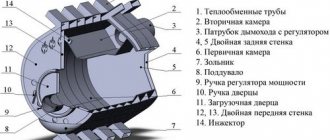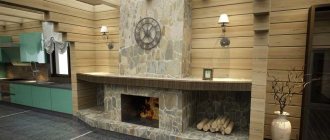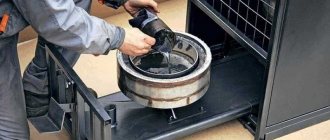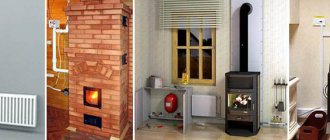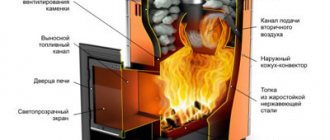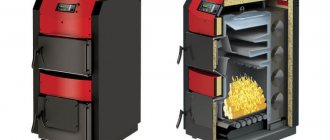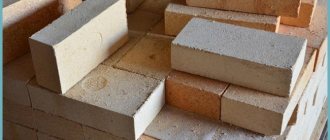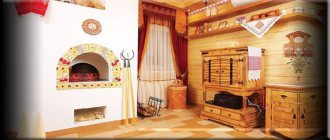A fireplace with a water circuit is the result of a combination of traditional stoves and solid fuel boilers. Its function is the same as that of a standard fireplace - heating the air in the building. It can work using wood or fuel briquettes. This creates a wonderful appearance of living fire.
Operating principle
A stove with a shell of water strongly resembles a chamber made of steel or cast iron. Depending on the models, the following wall thicknesses are manufactured:
- 0.4 cm with open model;
- 0.6 cm with closed model.
This structure mainly consists of a heat exchanger. It helps circulate the coolant. From the heat exchanger come pipes through which water flows into the heating system. It gets into the radiators. To accurately determine the temperature of the coolant, special sensors must be present. Typically, air flows are not regulated automatically, but by the person himself.
The exterior of the stove can be made from a variety of elements, which is why it can complement and decorate the interior. In some models, such structures have a hob that allows you to cook food.
Application
Stoves with such heating are used not in apartments, but in houses. Using such fireplaces is simple and safe, even if the fuel is wood.
The above qualities ensure considerable demand for them, especially with a hob. They purchase buildings in areas where gas and electricity supply is problematic.
In summer, a stove with a water shell can be used to heat water and use it in the household. Since such structures give off heat well, they will help a person save a lot on energy resources.
Advantages
Now a whole list of advantages of using a fireplace with a water circuit will be provided:
- Creating original comfort in the room.
- Autonomous operation guaranteed.
- Rapid heating of the room.
- A favorable type of fuel is firewood.
- Access to combination with any heating systems.
It has already been said above that the construction scheme can be supplemented with a hob. Food cooked with it has a special taste. It is much different from the taste of dishes that are cooked on standard electric or gas stoves, and even better. So the cooking addition is a beneficial advantage of wet-bed fireplace stoves.
Flaws
Each device also has its downsides. Eg:
- The work is not automated well enough.
- The efficiency (coefficient of performance) is lower than other more efficient heating designs.
But you can improve the hearth yourself, accurately calculate the length of the pipes and choose the right radiator material. Thanks to this, about half of the fuel resources can be saved.
Connection diagram for a fireplace with a water heating circuit
Hot air fireplaces - a combination of the beauty of fire and a practical element of the interior
Hot air fireplaces are a combination of a fireplace and hot air systems, that is, classic open fireplaces best provide natural human contact with the fire and allow you to enjoy the pleasant radiant heat of the fire and the crackling of burning wood. However, they have one unpleasant feature - they cannot heat the house efficiently. In winter they are convenient to use, but at the same time it is necessary to heat the house using another heating system.
However, most people, based on their practical experience, expect more from a burning fireplace - wood for the fireplace can always be prepared or purchased, and once it is burning in the fireplace, it would be useful to use the generated heat for heating, rather than venting it through the chimney. Therefore, fireplace inserts were created - steel or cast iron structures equipped with fireproof glass that cover the stove and receive most of the heat generated when wood is burned in the fireplace.
A fireplace stove, heated by a burning flame, is itself a powerful heater, emitting significantly more radiant heat than the fire itself in an open fireplace. However, due to the heat radiation of the fireplace insert, only the front portion of the insert, facing the room, can be used effectively for radiant heating. Most of the radiant heat is directed into the fireplace body. To use this heat for heating, fireplace inserts were supplemented with a system of air ducts and channels with a double shell, through which the air heats not only the fireplace insert itself, but also allows one or more rooms in the house to be evenly heated. Fireplaces built this way are called hot air fireplaces.
Hot air fireplaces operate on the principle of convective air flow, similar to convectors. They are based on a double shell fireplace insert which ensures both the efficient transfer of heat from the fire by inserting a hot bed through the air, and on the other hand, it directs the air from the lower suction port to the upper exit opening on both sides, like the front of the fireplace insert , and from all sides, the air that warms up does not escape through the chimney. Behind these openings is a duct system that typically connects to intake and exhaust grilles located in the fireplace body.
One air fireplace can heat one room and the entire house.
To distribute warm air in a room with a fireplace, circulating air is sufficient, with lighter heated air rising from the fireplace through the vents to the ceiling, and the hot air intake drawing in lower air through the bottom vent. If it is necessary to heat a larger number of rooms, it is necessary to install a hot air heating system in the house, that is, an air conditioning system with fans. Thus, it is possible to heat rooms from one fireplace with sufficient power at a distance of up to 15 m from the fireplace. Most of the fuel can be saved by connecting the fireplace to a water heating circuit and thus saving resources.
Types of fireplaces
Water fireplaces are conventionally divided into two types:
- Designs in finished form. Heat exchangers are provided in order to connect the heating system to such a structure.
- Structures that at the base look like a fireplace insert. There is a water heat exchange circuit.
All these types can be characterized by their individual merits. It is better to learn more about each of them.
Finished structures
This type is purchased ready-to-use. It only needs to be placed in a suitable area and connected to the heating of water resources. The chimney is also installed.
If you put a solid fuel boiler in comparison with such a stove, then the finished design has clear advantages. The hearth not only increases the temperature of the coolant, but also heats up itself. Thanks to this, the building itself warms up.
One of the advantages of this structure is that it can be transferred from one site to another.
A fireplace with water heating can be:
- Of steel.
- Made of cast iron.
Cast iron models boast such qualities as durability and good heat retention. Steel samples are more affordable. There are also models with tile finishing. At the same time, heat is retained longer, and a more attractive appearance will easily decorate the room. However, one of the disadvantages is the high price.
Devices with a base in the form of a fireplace insert
The appearance of such a structure with a water jacket is very similar to the classic version. True, this model is more complex than a standard oven. But the heating efficiency clearly increases. Such a device allows not only to heat the resource coolant, but also to ensure the efficiency of air convection, which is caused by the enclosure equipment.
Such structures are divided into two groups:
- closed form;
- open form.
The design contains a heat exchanger, thanks to which the energy resource is transferred to the heating system during the combustion of fuel materials. The process takes place through radiator pipes located almost everywhere within the room.
The design contains a heat exchanger, thanks to which the energy resource is transferred to the heating system during the combustion of fuel materials
Buying fireplaces and reviewing models
Today there are many offers of such devices on the market. You can purchase a fireplace in an online store or a specialized point of sale. The main thing is to know the characteristics you need.
To purchase online, you can use the search in Yandex.Market, where you will find a fairly wide selection of fireplaces with a water jacket for any budget.
To find the nearest point of sale, come and look at the product in person and consult, we recommend using Yandex.Maps. In the search, enter a request for the sale of fireplaces, and all the points where you can buy them will appear on the maps.
The cost of a heating device varies from 30 to 300 thousand rubles. Below we will look at several models.
Characteristics of the Varta Aqua fireplace stove with stove and water circuit:
- total thermal power: 14 kW (140 sq. m);
- heat exchanger: steel 5 mm thick, volume – 4 l;
- dimensions (HxWxD): 890x550x415 mm;
- water circuit power: 5 kW;
- weight: 150 kg;
- chimney diameter: 150 mm;
- price: 23-25 thousand rubles.
The EdilKamin Acquatondo 22 Prisma fireplace insert is equipped with a water circuit and a lifting door with prismatic glass. Main characteristics:
- dimensions (HxWxD): 1380x800x680 mm;
- cross-section: 220 mm;
- volume of heated room: 530 cubic meters. m;
- power: 26 kW;
- Efficiency: 79%;
- warm water selection: 60%;
- fuel consumption (wood): 6.5 kg/hour;
- fluid capacity: 14 l/min;
- weight: 230 kg;
- price: 230-270 thousand rubles.
The Ferlux C-21W fireplace insert with a damper is equipped with a water circuit and a removable ash pan. It is possible to open the door to the side, and the combustion air supply can be adjusted. Main characteristics:
- external dimensions (HxWxD): 670x692x480 mm;
- internal dimensions (HxWxD): 415x572x330 mm;
- glass thickness: 4 mm;
- rated power: 12.5 kW;
- water circuit power: 3.7 kW;
- liquid tank volume: 7 l;
- heated volume: 150 cubic meters m;
- Efficiency: 72%;
- chimney diameter: 180, 200 mm;
- fuel: firewood;
- weight: 119 kg;
- price: 55-65 thousand rubles.
Choosing a fireplace
To increase efficiency and safety during heating, it is necessary to pay attention to the following concepts when purchasing, installing and using modern fireplaces:
- Power selection.
- Selection of casing and heat transfer material.
- Safety criteria during connection.
- Rules for connecting a stove to a heating system.
- Recommendations and conditions for the construction of a chimney.
- Selection of fuel resources.
- Proper cleaning, maintenance and heating of the stove yourself.
In addition, production advice must be taken into account, which must be mentioned in the documents. By following the above rules, using the stove will become safe, and it will serve for a very long time.
One important criterion that you also need to pay attention to before purchasing any model is the power of heat generation during heating. To measure it, kilowatts are used. It was calculated that with 1 kW of heating power it is possible to warm up about 10 m² of space.
True, it is also necessary to take into account the fact that during production it is tested under almost ideal conditions, and indoors the power can decrease by almost 3 times if fuel resources (firewood) that are not completely dried are used. So, in order to use a fireplace with a water layer as the only source of heating, it is advisable to purchase a model with an additional supply of power.
Steel or cast iron
Water-heated fireplaces can be made of steel or cast iron. The cost of steel is much lower. The steel itself is light, however, it is highly susceptible to corrosion. If the stove is made entirely of cast iron, then it will be durable and resistant to corrosion. The disadvantages include too much weight and intolerance to sudden temperature changes, which can cause cracks to appear.
The best option is combined models. In them, steel elements are present in the body and in slightly heated parts. And wrought iron is seen in doors and grates that are subject to excessive heat.
High temperature levels will not affect this combination, and you can use it all the time without interruption. As a result of periodic heating, the pipes are filled with condensate, which prevents corrosion.
In order to use a fireplace with a water layer as the only source of heating, it is advisable to purchase a model with an additional power supply
Main disadvantages
Experts carried out many calculations after which they drew conclusions and identified the main disadvantages of a boiler with a water circuit:
- high price category;
- insufficient automation of the process;
- efficiency indicators are low;
Photo 5 Open heating system with pressure up to 1.5 bar, heating area up to 350 m2, with a hot water tank (DHW) and a hydraulic accumulator (HUF).
Compared to a boiler powered by electricity, installing a device with a water circuit is several times more expensive. However, we will correct this minus, because The payback of the system is quite fast. But the low level of automation is due to manual startup of the device. However, this drawback is not so significant.
If you choose such a fireplace as the main heating device, when severe frost sets in, its power will not be enough to warm up the living space. The efficiency is at an average level, so the device is not suitable for cold regions.
It is important to know! A fireplace with a water circuit is a backup mechanism and is installed in rooms with a small square footage. It is advisable to mount it in conjunction with a gas boiler. In this case, the savings in combustible materials reaches 30%.
Fireplace installation
In order for the stove to start heating the room, you need to connect it to the heating system. For this, special tools and materials are used:
- Stand for installing a fireplace.
- Expansion tank.
- Copper pipe to attach the structure.
- Controller to control the heating process.
- Thermal protection is a sensor that protects the stove from boiling. That is, when the water temperature reaches 90˚C, the water is transferred to the circuit.
- Anti-explosion valve. In other words, this protects the furnace from excessive pressure increases.
- Connecting elements: valves with couplings, sanitary technical connections that are used during installation.
- Heat exchanger , if the connection form is open.
Fireplace connection diagrams
- Open. In this case, there must be a special expansion vessel, which must be located above the furnace and work as communicating containers. Then the water that is heated in the furnace is transferred from the heating system, passing through a heat exchanger.
- Closed. The hearth is connected immediately to the heating system, without passing through the expansion tank and heat exchanger.
The scheme is selected depending on certain situations. Experts believe that the open form of the system has increased security, but it is not always possible to connect it technically.
Autonomous fireplace heating scheme
Positive aspects of the system
A fireplace with a water jacket operates through a boiler (gas or solid fuel type). It is this scheme that is the most effective and safe. The main advantages of a water heating system:
- quick switching on of the heating device;
- small time costs to fully warm up the room;
- long service life;
- aesthetically attractive appearance;
- use of environmentally friendly materials in production;
- high degree of fire safety.
Even if the heating was turned off for a long time, for example, when the owners left, going into a cold room and turning on the fireplace, the room will warm up quickly enough. Thanks to the closed firebox, the efficiency of the furnace device reaches 85%. The unit is also equipped with double metal walls, inside of which there is a heat exchanger.
It is important to know! The fireplace is not the main one in the heating system - it is an additional element in the heating line. By connecting the unit to the water circuit, the coolant circulates through the pipes.
Photo 4 The stove device can serve as an independent heating mechanism or be an addition to the overall heating circuit.
If necessary, a fireplace can provide good heating in the house. The double walls in the combustion chamber are not prone to overheating, so the device has positive performance characteristics. There are also no rules for the location of the fireplace - it can be installed anywhere. Thanks to the closed combustion system, the maximum degree of fire safety is ensured.
It will also be useful to study additional materials on our portal about the design of a pellet boiler.
Efficiency of a water-heated fireplace
During 7–9 hours of the night, 63–65 kW of energy is wasted so that the room can be heated.
The boiler plays an important role here, without which it is impossible to accumulate thermal energy and optimize its use by time of day. In addition, the boiler is able to prevent possible overheating in a stove with such a shell. To activate this function, you need to fill no less than the calculated amount of water.
During heating, the boiler begins to take water heated to 80 -85 oC from the boiler. It flows through a coil that is built into the boiler. In this case, the heat of the water is given off, the water gives off heat and heats the water located there. The coolant is cooled to 60 °C, and it goes back to the heating heat exchanger.
Water with a temperature of 85 ° C is applied to radiators and floors. The cooled resource again goes to the boiler storage tank.
To accumulate those 65 kW of thermal energy, the boiler must hold no less than 500 - 700 liters.
To determine the volume of a given drive, use the following formula:
M = 65,000 W/h / (90–30) deg × 1.638 W/deg kg = 633 kg
Where:
1.638 W/degree kg - the amount of heat released or absorbed to change the temperature of 1 kg of water by 1 degree.
Considering the fact that the mass of water is almost always equal to the volume of water, these 633 kg must be equated to the volume, and the result will be 633 liters.
A storage boiler with a volume of 750 liters has the following dimensions:
- Height – from 1.6 to 1.9 m.
- Diameter - no more than one meter.
- The mass of this storage device with a thermal carrier is 1.2 tons.
To place this structure you need to have a sufficiently strong foundation and site in the building.
It is possible to use boilers with a smaller capacity and maintain the desired temperature level at night using built-in electric heaters. True, if you do this on the coldest and frostiest days, overheating is possible. And to prevent emergency cooling during heating, you have to periodically pour some of the hot water outside.
Reviews of the fireplace stove with a water circuit
If we consider reviews of such a stove, small contradictions often arise regarding this structure with this circuit.
A large number of positive reviews were left by those people who were able to install such a system in small houses or cottages:
“...My housemate told me about the existence of a water fireplace. I immediately found this interesting. Without thinking for a long time, I built a metal sample. I'm a good welder, of course. I also built a water heating system and connected a coil to it. I didn’t pay attention to the batteries, I simply combined the entire system with metal pipes. Their diameter is almost 6 cm. As a result, everything works perfectly and accurately...” Nikolai Nikolaevich, Vyazma.
“...We bought a fireplace with a water layer and a circulation pump. They called a specialist to connect. Everything was fine, but as soon as the power was turned off, everything stopped. The pump no longer pumped water, and the batteries began to cool down. Very soon the house became cold. This is a huge drawback of such a stove. We had to adjust the system to the natural circulation of water. So it’s better to think things over before purchasing this stove. Boris, Nikolaev.
"…I liked him. We just ran the pipes and connected the radiator. It turned out to be a good heating system. We drown with wood...” Oleg, Kirov.
“...I wanted to buy a stove with a wet circuit for my own home. The cost was not too high. I surfed the Internet, looked at photographs and videos, and talked with experts. As a result, the system is highly efficient. True, the only downside I can notice is the constant loading of firewood and cleaning. However, warmth and comfort will cover them...” Maxim, Izhevsk.
“...I bought this product. Online reviews and recommendations have been positive, and for good reason. Installed and mounted it myself. I learned about the result immediately. It heats the entire area of the dacha evenly, while you didn’t have to spend much..." Grigory, Cheboksary.
Basic elements and connection diagrams
The components of a traditional metal fireplace, which you can assemble with your own hands, are very simple:
- circulation pump;
- heat exchanger;
- water tank;
- heating radiators;
- hydraulic accumulator;
- coolant temperature sensors;
- three-position tap.
The heat exchanger performs the function of a general structural element. It is located in the firebox, coolant is supplied to it from the expansion tank, and from it, using a circulation pump, water is delivered to the batteries. The hydroaccumulator is connected to heating radiators, but as close as possible to the metal stove.
Diagram of a fireplace with a closed water circuit:
The hydraulic tank is installed parallel to the heating system. You can close it with a special three-position tap. A circulation pump is mounted in front of the hydraulic accumulator, which ensures the movement of the coolant along the heating line.
Before turning on the unit, you must make sure that the water circuit is connected to the device and the system is filled with coolant, so as not to damage the structure of the device.
Important: The amount of water in the system directly depends on the area of the heated room and the number of circuits. A double-circuit system requires a doubling of the coolant volume compared to a single-circuit wiring.
A closed heating system differs from an open one in that in the second case a pump is not used to supply water to the device. The coolant enters the heat exchanger naturally under the influence of gravity. That is why the expansion tank should be installed at the highest point in the house, for example, in the attic.
Blitz tips
- It is advisable to buy fireplaces from well-known brands , since such companies produce the product taking into account the high established standards.
- The product must include special documents: a certificate indicating quality, a passport, instructions for use and connection.
- Before purchasing, you need to read reviews from other people to be completely sure of the winning purchase option. However, positive reviews do not always indicate a stove warranty.
- It is necessary to ask the seller about the terms of warranty service.
- Before choosing a model and its power, you need to accurately calculate the area of the building so that the room is heated to the maximum. Under standard conditions, for a ceiling height of 2.5 meters, energy of 1 kW per 10 m² should be spent on heating.
- Without leaving the store, you need to test the performance of all moving elements of the stove , see if the glass door is intact and if the connections with the water heating circuits are strong.
How to choose a water fireplace?
Before purchasing a fireplace with a water heating circuit, you should take into account the volume of the combustion chamber, on which the power of the device depends. The larger the volume, the more heat is released to heat the room.
Fireplace with a large combustion chamber. Suitable for heating a large house
You should pay attention to the power of the fireplace, namely the nominal one. At the maximum power, which is also indicated in the product data sheet, it is not recommended to use the device. This may lead to a decrease in working life.
When choosing a fireplace power, we are guided by the following factors:
- Permanent residence in the house.
- Power usage restrictions.
- Area of premises.
- Possibility of device maintenance.
When choosing the power of the fireplace, the area of the house is calculated. A margin of at least 15% is added to the resulting figure. If you plan to live in the house permanently and use the fireplace, then you need to properly distribute the heating system. The heat should be evenly distributed throughout the rooms.
A fireplace stove with a small firebox volume. Suitable for a small house or one room

